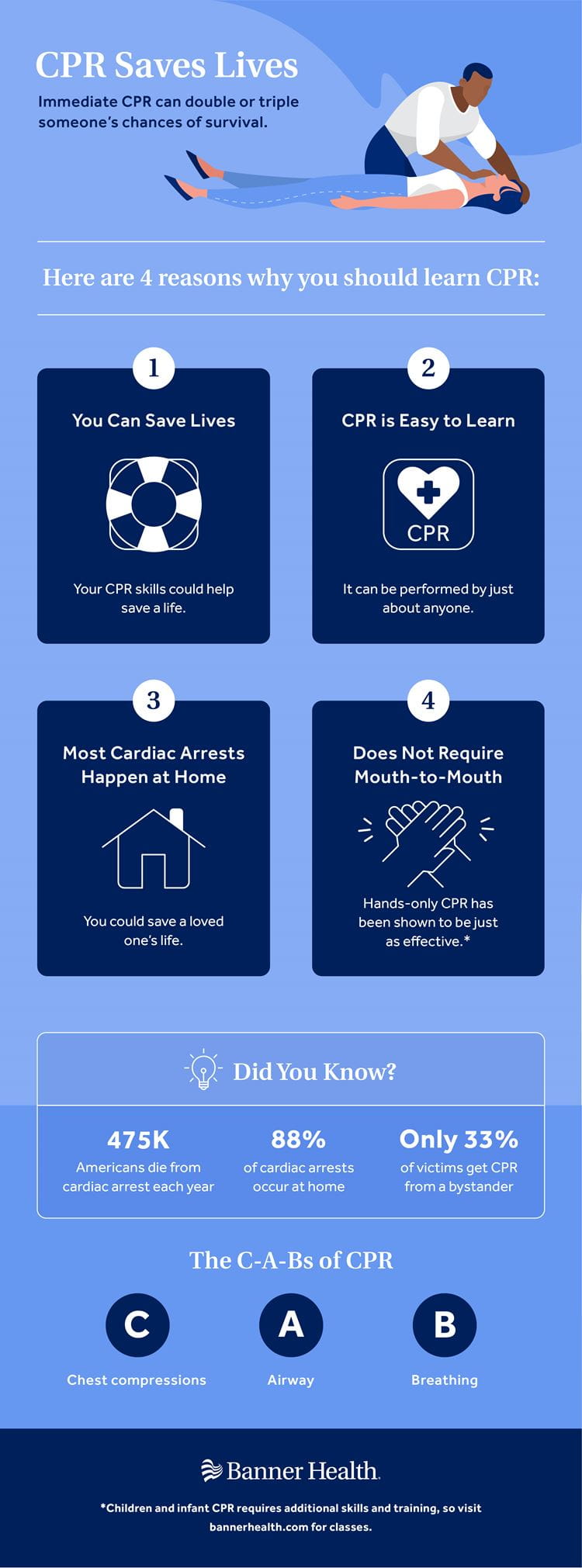Can you remember the first time you ever learned how to ride a bike? It was pretty hard, right? But today, you can’t imagine ever not knowing how to do it … hence the old expression, “It’s just like riding a bike.”
Now imagine if learning a new skill was easier than that first time you learned to ride – like super easy. A skill that could even save a person’s life—maybe even a family member.
What’s this skill, you may ask? It’s learning CPR (cardiopulmonary resuscitation), a life-saving technique used to help maintain blood flow to the brain and heart in an emergency situation. While you might think this skill should be left to professions like lifeguards, healthcare providers and childcare workers, CPR training is crucial – even lifesaving – for everyone to know.
“If immediate CPR is used, you can double or triple someone’s chances of survival,” said Tracey Fejt, RN, trauma outreach and injury prevention coordinator at Banner Children’s at Children’s Medical Center in Mesa, AZ. “Only about 8% of sudden cardiac arrests survive outside the hospital because CPR was not done prior to EMS arriving.”
If these stats don’t give you reason enough to Google CPR trainings in your area or online, Fejt shared four other reasons it’s worth learning this easy yet lifesaving skill.
1. You can save lives
Each year, about 350,000 cardiac arrests occur outside of the hospital. Cardiac arrest is described as a sudden, unexpected loss of heart function, breathing and consciousness.
If someone experiences sudden cardiac arrest, it is essential to start CPR within minutes. Although emergency personnel send help as quickly as possible, if CPR is not initiated, within minutes, it could lead to a brain injury, damage and even death.
“We can’t control what will happen tomorrow, but you can do everything possible to save someone’s life,” Fejt said. “Think of the places you go during the day – walking your dog, grocery shopping or being at work – there so many lives you can potentially save."
2. CPR is easy to learn
One of the biggest benefits is the fact that CPR can be performed by just about anyone at any time. You don’t need an RN or MD after your name. You don’t even need a special certification or formal training to perform CPR, but you do need education.
“Learning hands-only CPR, or chest compression-only CPR, can be as simple as watching a 2-minute online video or taking a course through your local fire departments, hospitals or the American Heart Association,” Fejt said. “If you are a teen or adult, you can perform it with just two easy steps.”
These two steps are:
- Call 911
- Push hard and fast in the center of the victim’s chest to the beat of the Bee Gees song “Staying Alive” or Justin Timberlake song “Can’t Stop the Feeling,” roughly 100 to 120 compressions per minute, until help arrives.
“Although hands-only CPR is life-saving, there is one additional thing you’ll need to learn for infants and children,” Fejt said. “If you will be around infants and children, you will also need to learn additional skills, such as rescue breathing.”
For others whose jobs require them to be certified in CPR (along with AED training and/or First Aid), an in-person CPR class is necessary to ensure you have the proper paperwork to confirm your certification and means you should re-certify every two to three years.
3. Most cardiac arrests happen at home
Did you know that 88% of sudden cardiac arrests occur at home? Hopefully you’ll never have to use your skill but knowing CPR can give you the confidence to help save a family member’s life.
Most people think sudden cardiac arrest only happens to adults, but it can affect anyone at any age. This is why it’s a great idea for new parents and caregivers of infants and children to learn. There has even been a big push in some states like Arizona to bring CPR training to schools.
“Currently, most states require CPR training before graduating high school,” Fejt said. “Now 38 states have passed laws or adopted curriculum for students.”
4. Does not require mouth-to-mouth
For those fearful of touching lips or mouths with a stranger, here’s some good news. If you don’t feel comfortable or haven’t received formal training, hands-only or compression-only CPR has been shown to be just as effective on those who experience sudden cardiac arrests.
For certified providers, mouth-to-mouth resuscitation, or rescue breathing, is still a critical component of performing CPR.
Don’t Wait – Get Trained
CPR can save someone’s life, so it’s crucial to get trained and easy to learn. To find a CPR training near you, visit bannerhealth.com or cpr.heart.org.



